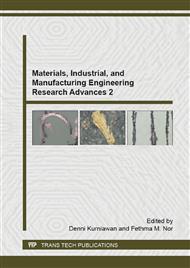p.484
p.489
p.494
p.499
p.504
p.511
p.516
p.521
p.526
Microstructure and Properties of Forged CoCrMo Alloy for Load Bearing Application
Abstract:
CoCrMo alloy are known to be widely applied as biomedical implant materials. They have been practically used for artificial knee joints and hips. This is due to their excellent corrosion and wear resistances as well as good mechanical properties and biocompatibility. This published work is a research to improve the tensile properties of the alloy for load bearing application. This approach is an innovative process that will enhance the mechanical properties of the materials against the conventional processing technique while reducing the number of steps and energy consumption in producing the final parts; hence more economical. Grain refinement is expected to promote significant enhancement in both properties. Preforms are prepared through powder metallurgy route prior to the low strain rate upset forging process. The alloy powder was mixed with zinc stearate as a binder at different milling times. The formulated powder is compacted and then sintered at different temperatures. Characterization of the sintered parts are studied on their microstructure, density, hardness and transverse rupture strength (TRS). Further characterization was done using transmission electron microscopy (TEM) to study the grain refinement in enhancing the properties of the material.
Info:
Periodical:
Pages:
504-508
Citation:
Online since:
October 2015
Price:
Сopyright:
© 2015 Trans Tech Publications Ltd. All Rights Reserved
Share:
Citation:


